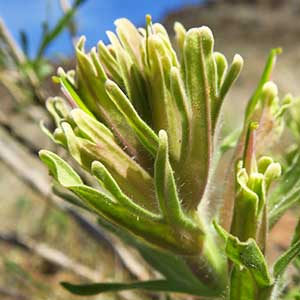Castilleja xanthotricha
Castilleja cinerea
John Day or yellow-hairy paintbrush, John Day paintbrush, yellow hair paintbrush, yellow-hair Indian paintbrush
ash-gray Indian paintbrush, ash-gray paintbrush
few to several, ± decumbent to erect or ascending, unbranched, sometimes with short, leafy axillary shoots, hairs erect to spreading, long, soft, eglandular, mixed with short stipitate-glandular ones.
several to many, erect to ascending, or decumbent, inflorescence erect in high-elevation form, unbranched, sometimes branched, hairs dense, spreading, ashy gray, short and long, soft, mixed with short stipitate-glandular ones.
green, linear, lanceolate to broadly lanceolate, oblong, or cuneate, 0.8–5 cm, not fleshy, margins plane to wavy, involute, 0–5-lobed, apex acute, sometimes rounded;
lobes spreading, linear, arising below mid length, nearly as broad as center lobe, apex acute.
green, brown, purple, or deep gray, linear or narrowly to broadly lanceolate to sometimes ovate, 0.7–3 cm, not fleshy, margins plane, slightly involute, 0(–3)-lobed, apex acuminate;
lobes ascending to spreading, linear to lanceolate, apex acuminate.
3–14 × 1.5–4.5 cm;
bracts proximally greenish, rarely dull reddish purple, distally white to cream, rarely pale yellow or dull, pale pink (sharply differentiated from proximal coloration), lanceolate or oblong to narrowly ovate, (3–)5–7-lobed;
lobes ascending, linear to obovate, ± broadened distally, medium, long, proximal lobes arising below mid length, central lobe apex broadly rounded to truncate, others acute to rounded.
1–8.5 × 2–5 cm;
bracts proximally greenish or deep reddish purple, distally burnt orange, sometimes yellow or deep red to deep burgundy, proximal sometimes lanceolate with narrow lobes, distal or all bracts broadly lanceolate to oblong or slightly oblanceolate, (0–)3–5-lobed, appearing dusty with dense, short stipitate-glandular hairs, many with a nodulose to pillarlike, crystallized, usually pigmented exudate, papillose at 40x;
lobes ascending-spreading, oblong or oblanceolate, short, arising above mid length, central lobe apex rounded, often expanded, rounded, or truncate, lateral ones acute to rounded.
curved, 17–23 mm;
tube 15–19 mm;
beak exserted, adaxially green, 5–8(–9) mm, puberulent, stipitate-glandular;
abaxial lip deep purple (color sometimes visible through calyx), green, pinkish, or pale yellow, ± prominent, slightly inflated, usually hidden in calyx, sometimes right at top of calyx, 2 mm, ca. 50% as long as beak;
teeth ascending, whitish, yellowish, pink, or green, 1–1.5 mm.
straight, 12–18 mm;
tube 9–14 mm;
beak included or tip just barely exserted, adaxially green or pale yellow to deep burgundy, 3–5 mm;
abaxial lip green, burgundy, or reddish purple (in high-elevation form), little inflated, small, included, 2 mm, to 20% as long as beak;
teeth incurved, green, 0.2–0.5 mm.
colored as bracts, 15–26 mm;
abaxial and adaxial clefts 3.5–7 mm, 25–50% of calyx length, deeper than laterals, lateral 2–5 mm, 12–25% of calyx length;
lobes linear, oblong, or narrowly triangular, center lobe apex usually rounded, lobes acute to rounded.
colored as bracts, sometimes whitish proximally, 1.5–20 mm (shorter in upper elevation form);
abaxial and adaxial clefts 3.5–8 mm, 30–50% of calyx length, all 4 clefts subequal;
lobes linear to narrowly oblong or oblanceolate, apex obtuse to rounded, densely stipitate-glandular.
= 48.
Castilleja xanthotricha
Castilleja cinerea
Castilleja xanthotricha is endemic to moderate elevations in the sagebrush hills of the John Day River drainage in north-central Oregon. N. H. Holmgren (1971) hypothesized that this tetraploid species is of allopolyploid hybrid origin between C. glandulifera and C. oresbia.
(Discussion copyrighted by Flora of North America; reprinted with permission.)
Castilleja cinerea is endemic to the higher elevations of the San Bernardino Mountains, San Bernardino County. Most plants are upright to ascending and have yellow to yellow-orange inflorescences, with occasional plants ranging to dull red, especially with age. On Sugarloaf Mountain, mostly above 2700 m, is a distinctive form with consistently reddish purple to burgundy inflorescences and a strongly decumbent growth form.
Castilleja cinerea is most often associated with and likely parasitic on Artemisia nova and Eriogonum species. Castilleja cinerea is known from few populations and is threatened by livestock grazing, development, and vehicle use. It is listed as a threatened species under the Endangered Species Act of the United States.
The crystalline exudate associated with the stipitate-glandular pubescence of the distal portion of the bracts is unique in the genus.
(Discussion copyrighted by Flora of North America; reprinted with permission.)
